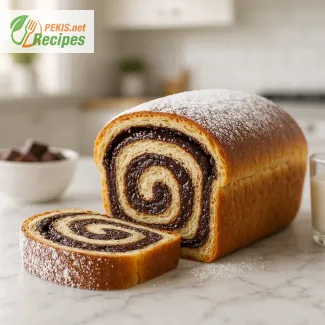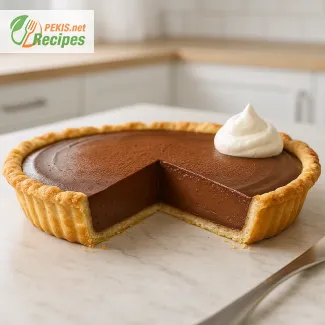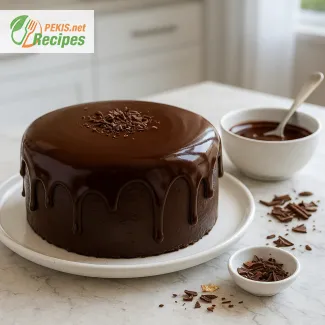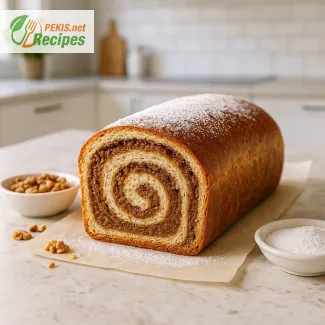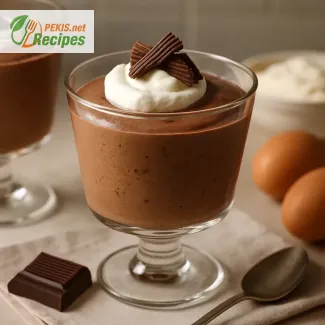
The Irresistible Charm of Homemade Chocolate Mousse
A silky, indulgent dessert that melts in your mouth with every spoonful
There’s something eternally captivating about a classic chocolate mousse. It's the kind of dessert that transcends age, occasion, and even culinary skill. Whether served in elegant glassware at a dinner party or simply enjoyed at home as a treat after a long day, chocolate mousse holds a special place in the world of desserts. With its light, airy texture and deep, rich chocolate flavor, it manages to feel both luxurious and comforting at once.
In this recipe, we explore the timeless appeal of homemade chocolate mousse, crafted with just a few quality ingredients and a gentle, precise technique. This is more than just a dessert – it's an experience. Each bite offers a delicate balance between sweetness and the intensity of cocoa, between creamy softness and the whisper of air whipped into the structure.
The elegance of simplicity in every spoonful
What makes this chocolate mousse recipe so compelling is its simplicity. No baking required. No complicated methods. Just good chocolate, fresh cream, eggs, and sugar – whisked and folded together to form a dessert that is light as a cloud yet deeply flavorful. The texture is crucial here: it should be smooth, velvety, and light, with a slight firmness that melts effortlessly once it hits your tongue.
This kind of texture doesn’t happen by accident. It’s the result of understanding the ingredients and treating them with care. Melted chocolate needs to be perfectly tempered, whipped cream folded in gently, and egg whites beaten to soft peaks for the signature mousse consistency. These steps create that signature light and fluffy structure while preserving the boldness of the chocolate.
Why chocolate mousse stands out among desserts
Few desserts manage to be both decadent and delicate, but chocolate mousse strikes that rare balance. It delivers the full-bodied richness of chocolate in a format that feels surprisingly light and refreshing. Because of its composition, it doesn’t weigh you down like heavier desserts. Instead, it’s the kind of sweet finale that leaves guests satisfied without feeling overindulgent.
Moreover, chocolate mousse is incredibly versatile. It can be served in small jars, ramekins, wine glasses, or layered into elaborate parfaits. You can top it with fresh berries, shaved chocolate, a dollop of whipped cream, or a sprinkle of sea salt. Its adaptability makes it suitable for everything from holiday dinners to romantic evenings or casual weekday desserts.
The quality of ingredients makes all the difference
To make the best chocolate mousse, the quality of the ingredients is paramount. A high-quality dark chocolate with a cocoa content between 60% and 70% is recommended for a balanced bitterness and depth. Heavy cream should be fresh and cold, while eggs must be at room temperature to whisk properly. These simple components, when combined in the right proportions, form the foundation of an unforgettable mousse.
One of the things that sets this recipe apart is its emphasis on real chocolate rather than cocoa powder. This ensures a deeper, more intense flavor and that luxurious mouthfeel that only true chocolate can provide. The addition of a touch of vanilla or a splash of espresso can elevate the flavor even further, adding a hint of complexity that plays beautifully with the chocolate.
A dessert loved across cultures and generations
Although often associated with French cuisine, chocolate mousse has become a beloved dessert across the globe. Its name, “mousse au chocolat,” evokes images of fine patisseries and candlelit bistros, but its simplicity has allowed it to travel far beyond France. You’ll find versions of chocolate mousse in every corner of the world, each slightly adapted but always retaining that essential identity: a soft, chocolatey cloud of joy.
There’s a reason this dessert never goes out of style. It taps into a deep, universal love for chocolate desserts, while offering a texture and elegance that few other sweets can replicate. It feels indulgent yet refined, traditional yet endlessly customizable. This dual nature is what keeps chocolate mousse at the top of dessert menus and in the hearts of food lovers everywhere.
Perfect for make-ahead entertaining and everyday indulgence
Another reason chocolate mousse is such a treasured recipe is its make-ahead nature. In fact, it improves with a little time in the fridge, allowing the flavors to meld and the texture to firm up perfectly. You can prepare it several hours in advance – or even the night before – and simply serve when ready, making it ideal for dinner parties, holidays, or meal prep for a luxurious mid-week dessert.
Even better, it scales beautifully. You can easily double or halve the quantities without compromising the final result, making it as well-suited for a cozy night in as it is for a large gathering. It’s the kind of dessert that always feels effortlessly impressive, even when it’s actually quite easy to make.
A timeless dessert you’ll make again and again
This classic chocolate mousse recipe will quickly become a go-to in your collection. It brings together everything we love about dessert – intense chocolate flavor, light texture, simple preparation, and beautiful presentation. Whether it’s your first time making mousse or you’re a seasoned dessert enthusiast, this recipe promises to deliver results that delight both the eye and the palate.
- Melt the chocolate: Break the dark chocolate into small pieces and place in a heatproof bowl over a pot of simmering water (double boiler method). Stir occasionally until fully melted. Remove from heat and let it cool slightly.
- Whip the cream: In a separate bowl, whip the heavy cream until it forms soft peaks. Place in the refrigerator until needed.
- Whisk egg yolks: In another bowl, whisk the egg yolks with the vanilla extract until the mixture becomes pale and slightly thickened. Gradually add the melted chocolate into the yolk mixture, stirring continuously until smooth and well combined.
- Beat the egg whites: In a clean, dry bowl, add a pinch of salt to the egg whites and beat until they start to foam. Slowly add the sugar while continuing to beat until stiff peaks form.
- Combine: Fold the whipped cream gently into the chocolate mixture using a spatula. Then, carefully fold in the egg whites in two additions, being cautious not to deflate the mixture. Mix until fully combined and smooth.
- Chill: Spoon the mousse into serving glasses or bowls. Refrigerate for at least 2 hours, or until set.
- Serve: Optionally, garnish with grated chocolate, whipped cream, or fresh berries before serving.
Enhancing the Classic: Creative Twists for a More Refined Chocolate Mousse
Expert tips, ingredient swaps, and flavor ideas to elevate your dessert
When it comes to chocolate mousse, few desserts command the same balance of elegance and indulgence. Yet even a recipe as timeless as this one can be refined, improved, or tailored to suit different preferences and occasions. Whether you want to deepen the chocolate flavor, adjust the sweetness, or make the dish lighter or more nutritious, small, deliberate changes can dramatically impact the final result. Below are tested ways to bring out the best in your homemade chocolate mousse.
Adjusting ingredients to enhance flavor and texture
Choosing better chocolate makes a difference
One of the most impactful ways to improve the flavor of your mousse is to upgrade the chocolate. While any dark chocolate will work, using single-origin chocolate or artisan bars with 65–75% cocoa content adds complexity and richness. These chocolates often contain subtle notes of fruit, spice, or earthiness that bring a layered profile to the mousse. Avoid overly sweet chocolate, which can overpower the balance of the dessert.
Use espresso or coffee to intensify chocolate depth
A classic trick used by pastry chefs is to add a small amount of espresso or instant coffee (about 1 teaspoon) to the melted chocolate. The bitterness of the coffee accentuates the deep cocoa flavors without making the mousse taste like coffee. This trick is especially effective if your base chocolate is on the milder side.
Adding liqueurs or extracts for complexity
Flavorful additions like orange liqueur (e.g., Grand Marnier), hazelnut liqueur (Frangelico), or even dark rum can transform the flavor profile and create a more luxurious experience. You can also add a pinch of sea salt or vanilla bean paste instead of extract to bring more aromatic depth.
Making the mousse lighter or richer
Whipped egg yolks for a more custard-like result
For a richer, more velvety texture, consider cooking the egg yolks slightly with a sugar syrup (soft ball stage) or in a bain-marie until thick and pale. This technique, known as pâte à bombe, adds structure and a silky mouthfeel while ensuring safety through pasteurization.
Folding in mascarpone or Greek yogurt
To increase creaminess while moderating sweetness, fold in a few tablespoons of mascarpone cheese or thick Greek yogurt into the whipped cream before combining with the chocolate. Mascarpone adds decadence, while Greek yogurt introduces a slightly tangy contrast that complements the richness of chocolate beautifully.
Healthier alternatives without sacrificing taste
Substituting dairy cream with plant-based options
For a lactose-free or vegan version, you can replace heavy cream with chilled coconut cream. It whips similarly and gives the mousse a faint coconut undertone, which many find appealing when paired with chocolate. Oat-based or almond-based whipped creams are also viable alternatives if you're looking for neutral flavors.
Lowering sugar content
You can reduce the sugar quantity by 25% without significantly affecting the structure. To keep the texture stable, ensure the chocolate you use is not overly bitter, or compensate with a small amount of maple syrup or agave nectar. Natural sweeteners like monk fruit or erythritol may also be used in moderation, especially in low-carb or diabetic-friendly versions.
Why homemade always tastes better
Preparing chocolate mousse at home allows full control over every aspect of the recipe — from the quality of ingredients to the level of sweetness, flavor intensity, and presentation. Store-bought or pre-packaged versions often contain stabilizers, preservatives, and low-quality chocolate substitutes. In contrast, a homemade mousse can be tailored to your personal taste, dietary needs, and occasion.
The process itself also contributes to the quality: freshly whipped cream, properly folded egg whites, and gently melted chocolate create a final texture that’s nearly impossible to replicate in mass production. It’s not just about taste — it’s about creating a dessert that feels alive, delicate, and personal.
Common mistakes and how to avoid them
Overheating the chocolate
Burning or seizing the chocolate is one of the most common pitfalls. Always melt it over gentle, indirect heat, ideally using a double boiler. Ensure the bowl never touches the simmering water, and stir frequently to maintain a smooth, glossy texture.
Deflating the whipped ingredients
Another frequent issue is overmixing when folding the cream or egg whites into the chocolate base. This can deflate the airy structure and result in a dense, heavy mousse. The key is to fold gently and patiently using a spatula, rotating the bowl and lifting the mixture from the bottom up.
Incorrect chilling time
If the mousse hasn’t chilled for long enough (minimum 2 hours), the texture may not be fully set. On the other hand, overchilling it for more than 24 hours can sometimes lead to a loss of fluffiness. For best results, consume within 4–8 hours of preparation.
Creative flavor combinations for seasonal variations
- Raspberry swirl: Add a ripple of raspberry coulis between layers of mousse for a tart contrast.
- Spiced mousse: Fold in a pinch of cinnamon, nutmeg, or chili for a warming note perfect for winter.
- Mint infusion: Add a few drops of peppermint extract for a refreshing twist, great for festive holidays.
- Salted caramel layer: A thin layer of salted caramel at the bottom of the glass adds richness and visual appeal.
Presentation upgrades that make a difference
Serving chocolate mousse in elegant glassware like martini glasses, vintage ramekins, or mini dessert jars elevates the visual appeal. Garnish with shaved chocolate, edible gold leaf, whipped cream, or citrus zest to complement the mousse’s flavor and give it a professional finish.
If preparing for a dinner party, consider layering mousse with crushed cookies, fruit compote, or nut praline to create a parfait. These additions offer textural contrast and turn a simple dessert into a memorable centerpiece.
By understanding the basic structure of chocolate mousse and applying thoughtful improvements, you unlock endless possibilities. Whether your goal is to impress dinner guests or simply treat yourself, each adaptation allows you to craft a mousse that’s uniquely yours, rich in flavor, and unforgettable in texture.
Allergens present in the recipe:
- Eggs
- Milk (dairy)
- May contain traces of gluten (depending on chocolate brand)
Tips to eliminate allergens and gluten:
- Replace heavy cream with coconut cream to avoid dairy.
- Use pasteurized egg substitute for a safer egg-free version.
- Ensure the chocolate is certified gluten-free and dairy-free.
- Iron: 4.5 mg – contributes to red blood cell formation and energy production
- Magnesium: 55 mg – supports muscle and nerve function
- Calcium: 50 mg – essential for bone health
- Potassium: 320 mg – aids in heart function and muscle contractions
- Vitamin A: 220 IU – promotes vision and immune function
- Vitamin D: 0.7 µg – supports calcium absorption and immune health
- Flavonoids (from dark chocolate): 170 mg – support heart health and reduce inflammation
- Phenolic acids: 40 mg – contribute to cellular protection and may lower blood pressure
- Catechins: 30 mg – help combat oxidative stress and improve vascular health
